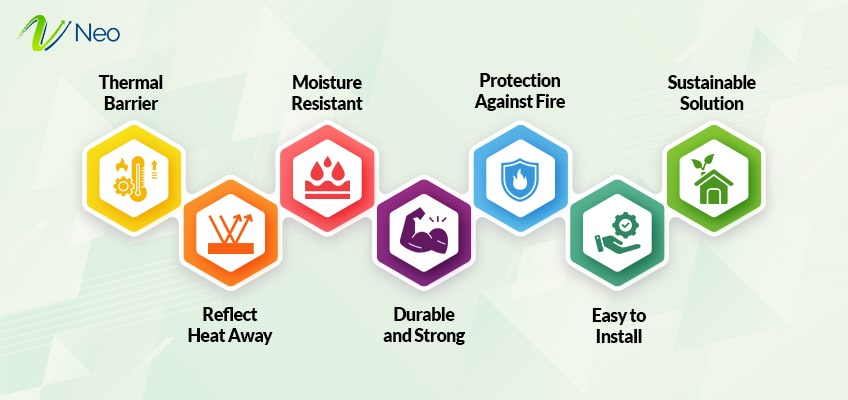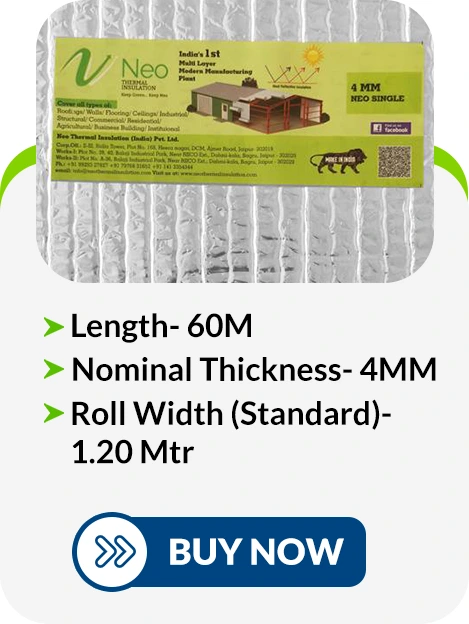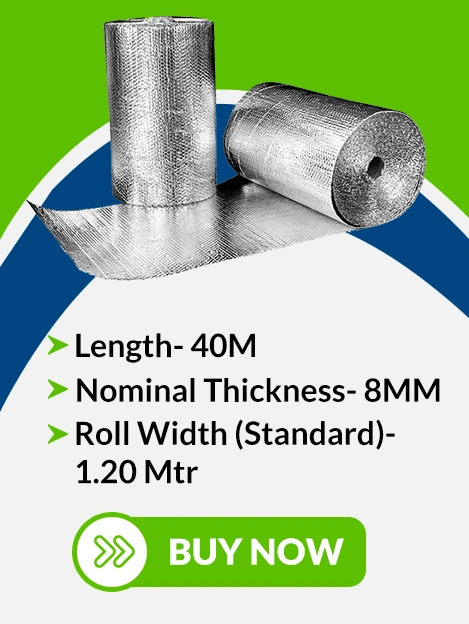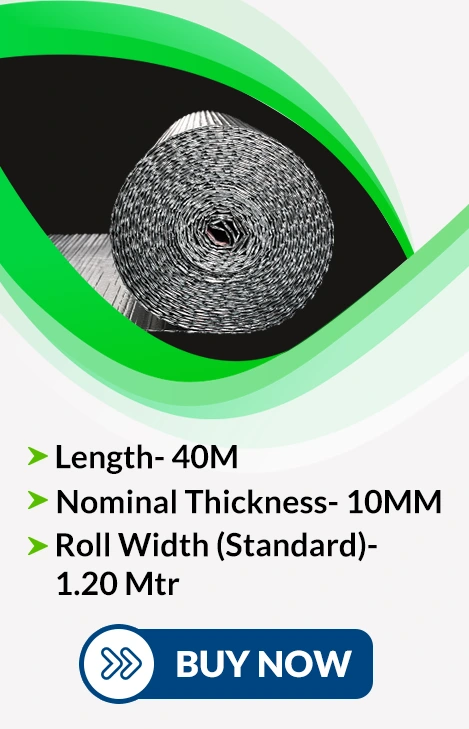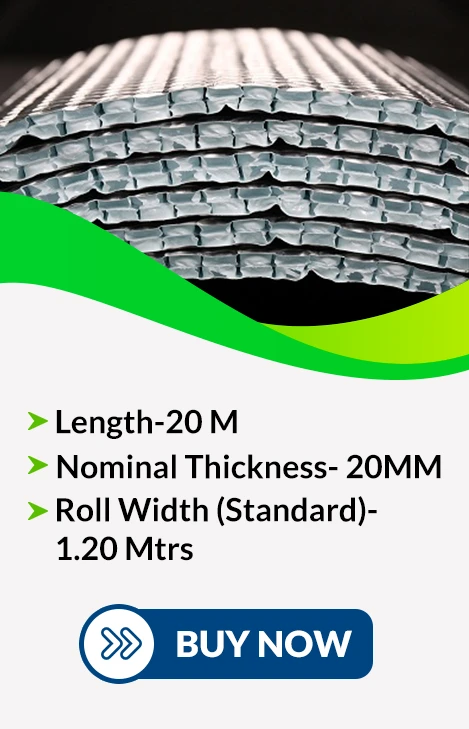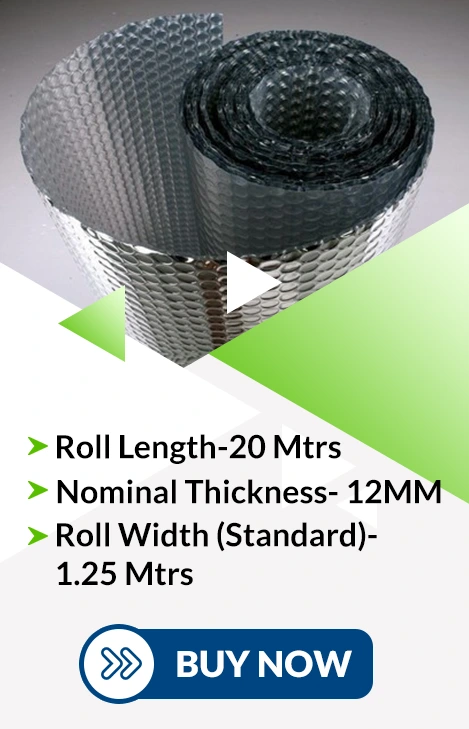Aluminum Foil Insulation(Price & How to Install)

Modern thermal insulation requirements need modern solutions, with the rise in demand for energy efficiency in the building and construction domain, demand for economical insulation techniques has surged rapidly. According to recent surveys, it is estimated that the global market for insulation materials including aluminum foil insulation is going to reach $93.34 billion by 2026 globally. It is also estimated that compound annual growth rate (CAGR) is going to be 5.1%. These data indicate that aluminum foil insulation is the new need for contemporary thermal insulation requirements. It not only offers profitable but also sustainable solutions with enhanced thermal comfort.
There are myriad benefits to using aluminum foil insulation in the construction and building domain. It is indicated by statistics that modern buildings consume 40% of total energy consumption globally, with abundant use of cooling and heating systems. However, aluminum foil insulation is the solution to this, as this economical material offers longevity, durability, and structural strength to buildings, it also offers sustainable solutions for maintaining consistent indoor temperature. It lowers energy utility costs and helps in mitigating greenhouse gas emissions. In the years to come, aluminum foil is going to play a very crucial role in promoting environmental health and quenching the thirst for modern insulation needs.
In this article, we will talk about aluminum foil insulation, the benefits of using them, factors that affect their pricing, and a step-by-step guide on installation techniques. This article will guide you through all the important aspects of aluminum insulation sheets so that you know what you are going to install to fulfill your thermal energy requirements.
Overview of Aluminum Foil Insulation
Aluminum insulation sheets comprise aluminum layers stratified with different insulating materials like foam, bubble wrap, paper, etc. for manufacturing flexible, lightweight, and durable insulation products. It is a multipurpose product with a wide range of applications and offers efficacious and cost-effective thermal solutions.
The principal application of this material is to reflect away the radiant heat. Due to aluminum’s exceptional reflecting property, the insulation sheets reflect up to 97% of the radiant heat and diminish the requirement of heating and cooling appliances for maintaining consistent indoor temperatures. It creates a barrier around the insulating surface and the surroundings for the transfer of radiant heat. Additionally, it serves as moisture resistant and barricades the entering of water vapor through the walls, roofs, and floors and creates a protective layer against corrosion.
Aluminum foil thermal insulation sheets have diverse applications, from walls to ceiling, floor to windows, pipes to HVAC ducts, these insulation sheets can be used anywhere according to the requirements. This larger number of applications makes it a perfect choice for modern residential and commercial construction projects. Also, it is durable, easy to install, and offers structural strength to the building spaces, all these qualities make it a perfect fit for insulation needs.
Benefits of Using Aluminum Foil Insulation
Aluminum foil insulation is known for its outstanding thermal insulation properties. The material is not only lightweight but also durable and offers strength to the insulating material. There is a myriad of benefits to using aluminum foil insulation.
Thermal Barrier:
The foremost reason for using aluminum foil for insulation is because of its distinguished thermal properties. It comes with air bubbles between the two metallic surfaces that act as a thermal barrier between the insulated material and the surroundings, and allow spaces to keep cool during hot weather and warm during cold weather. It improves the overall thermal efficiency of a building by reducing heat transfer using walls, floors, and ceilings.
Reflect Heat Away:
Aluminum foils reflect away the radiant heat and provide effective blockage against heat transfer through radiation. By reflecting heat rather than absorbing it helps the material to keep the interior temperature comfortable and reduces energy utility costs. Radiation which plays a vital role in heat gain and heat loss in a building becomes an insignificant player after installing aluminum foil thermal insulation.
Moisture Resistant:
It is one of the most effective properties of aluminum foil insulation to serve as a barrier against moisture. It protects insulated material and other building components from moisture damages like corrosion, mildew, mold, etc. These sheets restrict moisture from entering a building through walls, ceilings, flooring, and other surfaces. It is highly effective in areas with high humidity and where a risk of moisture intrusion is always present.
Seeking a Reliable Thermal Insulation Company?
Durable and Strong:
It offers durability, reliability, and longevity. It protects the building material against unwarranted wearing and tearing and ensures the effective working of the material during its serviceable life. The material also curtails unnecessary investment that is required to replace and maintain the material.
Protection against Fire:
Aluminum is a fire-resistant material and is known for its endurance at high temperatures making it a perfect fit for an insulating material. Aluminum foil insulation have high melting points thus reducing the risk of fire due to high temperature. It enhances the overall fire safety standards of a building and limits the spread of flames.
Easy to Install:
If we compare insulation aluminum foil with other insulation materials, one comprehends who is the winner. Aluminum foil is not only lightweight but also easy to handle. It saves labor costs and time as it is easily cut into different shapes and fittings and gets installed at a variety of places. Apart from that, the material has tremendous flexibility making it suitable for irregular spaces and surfaces, assuring proper fitting and sealing with maximum efficiency.
Sustainable Solution:
Aluminum insulation offer environment environment-friendly solutions to modern insulation needs. With the rising negative effects of construction and insulation on the environment, It is one step closer to sustainability efforts. It is made up of renewable resources like aluminum and it can easily recycled without losing its insulation properties. The material is the best fit for a sustainable solution for insulation as it has very less negative impacts on the environment.
Different Ways to Use Aluminum Foil Insulation?
Whether it is floor, roof, walls, attics, or HVAC ducts, aluminum foil has numerous uses. The sheet will be your best partner in the fight against thermal inefficiency, moisture, and structural damage. The variety of applications of aluminum fol insulation are listed below.
1. Walls:
It is very easy to install insulation sheets on walls and between wall studs because of its durability and flexibility. It can be precisely attached to the interior and exterior surfaces of the wall. It have air bubbles trapped between two metallic layers that prevent heat loss and gain using walls. It also serves as a barrier against moisture and prevents water vapors from causing damage to the walls.
Looking To Insulate Your House?
2. Roof:
Aluminum foil roof insulation is one of the best methods to prevent heat loss through walls. It can be applied either under roof rafters or on the roof deck to create a blockade against radiant heat transfer. It reflects away the solar heat to keep interiors cool and lessen the cost spent on electric appliances. It also prevents mildew and mold growth.
3. Floor:
Heat loss through floors is a serious concern for many people. However, installing it over and under floors will help in improving overall efficiency. It is more beneficial for places with raised floors and buildings where unheated spaces are present like basements and crawls. Aluminum foil for heat insulation helps in maintaining the desired indoor temperature and enhances energy efficiency as it evenly distributes heat.
4. Ceiling:
It can be effectively used for insulating ceilings and prevent thermal loss. It acts as a barrier between the ceiling surface and surroundings and curtails radiant heat transfer. Additionally, it inhibits moisture and vapor from entering through the surface and damaging the structure. It aids in maintaining comfortable indoor temperatures and lessens the load on electronic appliances.
5. HVAC duct:
Heating, ventilating, and air-conditioning ducts provide space for heat loss and gain through air entering the duct. It is necessary to insulate these ducts to ameliorate thermal efficiency. Apart from this, the aluminum insulation also restrict the implication caused by condensation on the surface of ducts.
6. Pipes:
Hot and cold water supply pipes need to be insulated to prevent heat loss and heat gain. It checks water pipers from becoming too cold in winter and too hot in summer and helps in maintaining desirable water temperatures in all weathers. It also reduces energy consumption.
7. Windows and Doors:
Openings like windows and doors need to be insulated to maintain appropriate indoor temperature. Aluminum foil that is heat reflective sheets should be installed on the window and door frames. This curtails radiant heat transfer between the room and the surroundings and unwarranted air leakage.
Pricing for aluminum foil insulation in 2024
Pricing for aluminum foil insulation depends upon a variety of factors. Factors like location, the complexity involved in the installation, quality of the material, market demand, and supply are some of the main points that impact the pricing for aluminum foil insulation.
Location:
Location plays a very vital role in determining the prices of aluminum foil insulation . The prices vary according to different countries and regions. Additionally, local market factors like manufacturing costs, transportation overheads, standard of living, and construction rates have an important say in fixing prices. The prices are higher in the regions where availability is low and demand is high and vice-versa.
Complexity in Installation:
Installation complexities affect the overall price of aluminum foil for heat insulation. If specialized skills, equipment, and additional materials are required in the installation process then the cost of the overall project goes up. Other factors like the total area required to be covered and accessibility also affect the price. Sometimes unique challenges also affect installation complexity and price.
Quality of the Material:
What kind of aluminum is used and what is the thickness of the sheet affects the cost. High-quality material with high durability and flexibility is sold at high prices. Material with exceptional thermal properties with moisture and fire resistance impacts the pricing of aluminum foil insulation.
Market forces:
Market forces, demand, and supply affect the pricing of aluminum foil insulation. When demand is high (during peak construction period) and supply is less then the price of the material goes up. However, when demand is low and supply is abundant then the price of the material goes down, and in this kind of period, suppliers try to adjust the prices so that customers get attracted.
Brand:
The reputation of the supplier and the authenticity of the brand have much to say in the pricing of aluminum foil for insulation. Brands that are established in the market and have an effective performance track record command high prices in comparison with local and less-known suppliers. Established brands also provide on-time customer support and expert guidance, these factors offer peace of mind to the customers and assurance regarding the product.
Quantity:
If insulation sheets are purchased in bulk or ordered in large quantities then suppliers will offer large amounts of discount. When construction companies buy under wholesale pricing it costs them less in comparison to purchases when an individual buys it in small quantity.
Step-by-Step Installation Process of Aluminum Foil Insulation
It is the right technique and approach that is required to install aluminum foil sheet for effective results. This step-by-step guide on the installation of an aluminum foil insulation will help in installing the foil properly and comfortably with maximum effects.
Step 1: Recognize the area
The first and foremost requirement is to select the area where insulation is required. After selecting the area clean the place, remove the debris and dust if present, and clear the obstacle if present, then start the installation process.
Step 2: Take proper Measurement
Measure the area that needs to be insulated by using proper methods. Also make sure to properly consider obstacles like pipes, ducts, and electrical wiring if any are present for the right measurement. It is important to measure the place efficiently for the best results.
Step 3: Use Adhesive
To follow this step is optional. Some kinds of aluminum foil insulation sheets require adhesive for proper installation in those cases a thin layer of high-quality adhesive is used to fix the sheet properly. It is advisable to follow the manufacturer’s instructions before applying adhesive.
Step 4: Place the sheet
After following the above steps now comes the time to place the aluminum foil insulation on the required surface. Assure to align the sheet properly and correctly over the surface in a way that it will cover the whole surface properly. After placing it, press the sheet with tight hands to avoid any wrinkles or air bubbles.
Step 5: Seal the Edges
Use the HVAC foil tape to seal the edges and joints present around the insulating surface after applying the sheet. Also, use the tape to join the seams of two sheets where they meet to create an uninterrupted thermal blockade around the openings like doors, windows, electrical switches, etc. to avoid heat gain and heat loss.
Step 6: Inspect the area
After installing the aluminum foil insulation sheet inspect the area properly and ensure that the surface is properly sealed and sheets are placed in proper order. In case there is any place left uncovered or sheets are not properly installed or loose then properly cover the place by using appropriate technique.
Points to remember:
- It is important to ensure that joints, edges, seams, etc. that are present around the insulating surface get properly covered to create an effective barrier against heat transfer. Use high-quality tape for joining aluminum foils and covering the gaps.
- Pay attention to small details such as cleaning the surface, taking proper measurements, and covering the gaps. Use an adequate amount of tape and adhesive to get proper results.
- Pay attention to the appropriate thickness that is required to insulate the surface. The right amount of thickness offers efficient thermal resistance and durability. Also, in the region where extreme climate fluctuation is a common phenomenon, pay attention to the details.
- It is advisable to read the manufacturer’s guidelines before installing aluminum insulation sheets. Instructions like how to use adhesive, the right sealing techniques, how to place sheets, etc. will help in achieving effective performance.
- In case you are not sure about how to carry on the installation process, then you can take the help of professionals who make the process easy for you. These experts will provide you with proper guidance, assure efficient installation, and help you in the maintenance of the installed sheet.
Conclusion
Modern construction business primarily focuses on thermal efficiency, lower energy costs, and sustainable building solutions. All these factors are now an essential part of modern construction requirements and this is the reason why demand for aluminum foil for thermal insulation is surging. Aluminum foil is an effective equipment in the fight against radiant heat transfer, it creates a thermal layer around the insulated surface and prevents the transfer of heat. Apart from this, it is durable, lightweight, flexible, easy to install, environment-friendly, and has a wide range of applications, all these qualities make it a perfect choice for modern construction and thermal energy requirements. Also, it is effective against moisture and provides economical moisture resistance with structural longevity.
For fulfilling insulation requirements in the construction business it is advisable to take the help of a professional brand who has a reputation in the domain. Neo thermal is the name that offers you high-quality insulation products specially crafted for outstanding performance and long life. Under the guidance of an expert team, the company offers fine-quality aluminum sheets with a variety of options including aluminum foil bubble wrap insulation sheets, reflective insulation sheets, aluminum heat insulation sheets, and aluminum foil insulation sheets for construction businesses and different industrial requirements. The insulation sheets provided by the brand have a wide range of applications, whether it is walls, ceiling, floor, roof, or HVAC ducts, they are feasible for all spaces with effective thermal proficiency. For cost-effective and energy-efficient solutions, endue with Neo thermal’s insulation options.
FAQs
1. How long does aluminum foil insulation last?
Aluminum foil insulation is known for its longevity and durability. If the right installation technique is applied, installation is done properly, and regular maintenance is provided then it will last for decades without any problem. It will provide long-term savings and thermal efficiency.
2. Can aluminum foil insulation be installed DIY, or should it be professionally done?
Yes, aluminum foil insulation can be installed DIY. If proper attention is paid and the right techniques are followed then it is easy to install. However, it is advisable to take the help of professionals in case of large-scale construction projects or in a situation where complexities arise. Attention to detail, adherence to guidelines, and proper safety measures are important for acquiring optimal efficiency.
3. What are the environmental impacts of using aluminum foil insulation?
There are no such negative environmental impacts of using aluminum foil insulation. This material helps in reducing greenhouse gas emissions and contributes to energy efficiency. These sheets are highly sustainable and easy to recycle without any quality loss. This makes it less dangerous for the environment. However, proper attention must be paid to its disposal and recycling to mitigate any danger.
